Are you about to have a baby soon and wondering exactly how maternity leave in Canada works?
Maternity and parental leave are available to all employed Canadians. Employers can’t fire employees on leave, but they don’t have to pay them. Instead, employees can receive their benefits from Employment Insurance.
While Employment Insurance provides benefits based on a percentage of your insurable earnings, a 2021 survey found that 58% of Canadian employers top off their employee’s maternity benefits.
Want to know more about parental leave in Canada? Keep reading.
What Is Employment Insurance In Canada?
Employment Insurance (EI) is a government program that benefits unemployed Canadians or those facing life events like illness, maternity or parental leave, or caregiving responsibilities.
You will need to apply for the benefit online, and if accepted, how much you receive depends on your circumstances.
While there isn’t a flat base rate to calculate your earnings, you can estimate that your benefit is 55% of your average insurable earnings. There is a limit on insurable earnings for the year, with 2022 coming in at $60,300. That means you can expect $638 per week.
Canada’s Maternity Leave
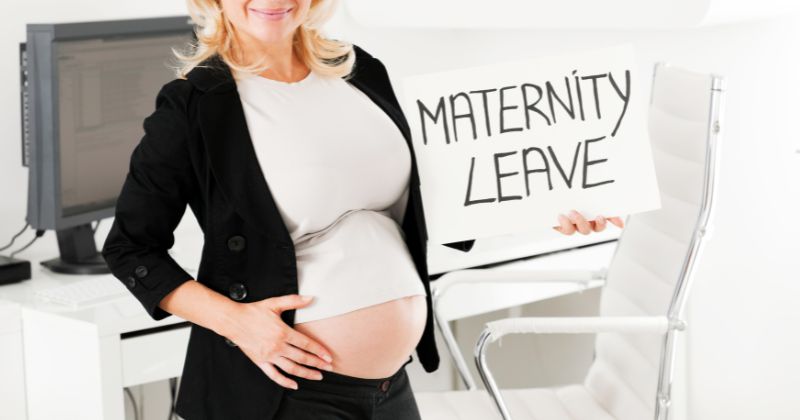
Parental leave in Canada is divided into two parts – maternity and parental leave. Employees contribute to Employment Insurance (EI) during each payroll cycle, which funds maternity or parental leave benefits for Canadian residents.
Self-employed individuals can make special contributions which grant them access to EI benefits after one year.
Maternity Leave Benefits
Maternity leave can start while still pregnant or on the date of birth. Parents can receive maternity benefits up to 12 weeks before the due date or date of birth. Only parents carrying the child are eligible for maternity benefits.
EI maternity benefits last for a maximum of 15 weeks, so make sure that you have plans in place after this period to stay on top of your finances. Parents will not be able to claim benefits more than 17 weeks from the due date or birth of the baby, whichever is later.
Paid Parental Leave
While maternity leave is only offered to biological and surrogate mothers, Canada does have a parental leave policy for other adoptive or legally recognized parents. Parental leave includes mothers who take maternity leave, as well.
You can choose between standard or extended benefits that get shared between parents or used by just one. Here’s how it works.
- Parents can split their benefits or use them on one parent.
- The leave can be simultaneously or one after the other.
- Parents can take the standard time of 40 weeks or extend it at a lower rate for 69 weeks.
Mothers who were eligible for paid maternity leave will also be eligible to receive paid parental leave after their maternity leave period has ended.
This means that mothers may receive up to 50 weeks of total benefits if they apply for a standard parental benefit and up to 76 weeks of total benefits if they apply for the extended parental benefit (see below).
Canadian parental leave includes all families, including LGBTQ couples and those who adopt. Each parent will need to submit their own application when applying for benefits. In addition, once the application is approved, parents can’t change their minds about how they wish to use it once benefits begin.
Here’s a quick table outlining the benefit rates you can expect for parental leave:
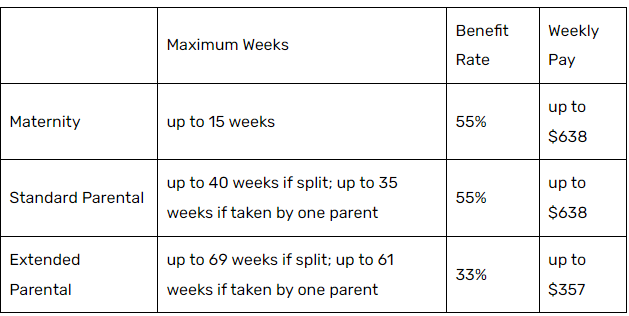
How Do Extended Parental Leave Benefits Work?
The chart above spells out the differences between maternity leave, standard parental benefits, and extended parental benefits.
When applying for their benefits, parents must select between either standard or extended parental benefits.
Parents may not choose to receive both benefits (i.e. – switching to extended benefits after receiving standard parental leave).
Whether you’re a co-parent or single parent, it’s vital to consider this as you financially plan for the future. While the standard benefit offers a higher amount, it only lasts 35 weeks for one parent or 40 weeks if split between two parents.
By contrast, extended parental benefits last up to 61 weeks if taken by one parent and 69 weeks if split between both parents. However, the weekly benefit payment is significantly lower.
Eligibility for extended parental leave benefits:
- You must have a newborn or newly adopted child
- You must have worked a minimum of 600 insured hours in the 52 weeks before the claim or since the start of your last EI claim, whichever is shorter
- Your regular weekly earnings have decreased by more than 40% for at least one week
How Do I Qualify for EI Maternity and Parental Benefits?
Here are the eligibility requirements to determine if you can apply for maternity and parental benefits.
- You’re pregnant or have recently given birth.
- You’re a parent caring for a newborn baby or adopted child.
- Your usual weekly earnings have decreased by more than 40% for at least one week.
- You accumulated 600 insured hours of work in the 52 weeks before the start of your claim or the last one, whichever is shorter.
A woman with an uncomplicated pregnancy can request maternity leave at the birth of the child or 12 weeks prior. However, if you experience problems during the pregnancy, you can qualify for health and sickness benefits instead of maternity leave.
Are Parental Benefits Taxed In Canada?
In Canada, both maternity and parental leave benefits received through EI are considered taxable income.
This means that both federal and provincial/territorial taxes will be deducted from your weekly benefit payments.
When you receive your EI benefits, the government withholds a certain percentage for tax purposes at the source, similar to how income tax is deducted from a regular paycheque.
It’s also important to note that the amount of taxes withheld from your maternity and parental leave benefits may not necessarily cover your total tax obligation for the year, especially if you have additional sources of income. This means that you may end up owing extra taxes when you file your annual tax return.
At the end of the tax year, you’ll receive a T4E slip (Statement of Employment Insurance and Other Benefits) from Service Canada detailing the amount of benefits you’ve received and the taxes that have been deducted.
You’ll then use this information to complete your annual income tax return, where the benefits are reported along with other sources of income to determine your final tax liability.
Can You Receive Parental Benefits After Adoption?
Just as parental leave benefits are available to biological parents, they’re also available to those with a newly adopted child.
Whether the child is older or they’re still a baby, this gives parents the crucial bonding time with their new family member.
Adoptive parents must meet the same eligibility criteria as biological parents, such as having worked a minimum of 600 insured hours in the 52 weeks preceding their claim or since the start of their last EI claim, whichever is shorter.
Once approved for the benefit, adoptive parents can opt for either standard or extended parental benefits, as we discussed above.
Like other forms of EI, adoption-related parental benefits are subject to federal, provincial, or territorial taxes.
Applying for Maternity and Parental Benefits
Once you’re satisfied that you’re eligible for federal benefits, you can apply online at the Government of Canada website.
To start, you’ll need to choose your benefit option, either maternity or parental leave. As the one giving birth, you can apply for both maternity and parental benefit at the same time.
You’ll be required to provide the following information:
Personal Info
- Names and addresses of employers within the past 52 weeks, along with dates of employment.
- An explanation detailing why you quit or got fired from a job within the past 52 weeks.
- Home address
- Social insurance number
- Banking information if you sign up for direct deposit
- Your baby’s due date or actual date of birth.
- The date your child was placed with you for adoption.
After submitting your application and all pertinent documents, you’ll receive a benefit statement and a four-digit access code. You’ll need these items to check on the status of your application.
Parental Leave By Province
The maternity and parental leave policies discussed above are federal benefits parents can receive if they qualify. However, each province and territory has its own length of leave.
Provincial governments cannot shorten the maternity and parental leave set out by the federal government. Instead, they can extend it, but that doesn’t mean the federal benefits get extended.
For example, Ontario allows 17 weeks of maternity leave, but that does not mean the parent taking the leave is entitled to 17 weeks of benefits. The federal government provides 15 weeks of maternity benefits even if a province allows a longer leave.
The same deal applies to parental leave. The bottom line is that even if a province allows a longer leave, that doesn’t mean extended federal benefits.
Each province and territory has different maternity and parental leave options. However, they almost always have the following in common.
- Maternity and parental leave are two separate situations. However, they can overlap.
- Employees can still participate in other benefit plans (health insurance, etc.) while on leave. In addition, they can earn credit for their length of service, including seniority.
- Employers cannot penalize an employee on leave or about to take leave.
- The provinces do not pay employees during their leave.
Detailed below is a table that breaks down maternity and parental leave by province and territory. The table also includes how long an employee needs to be at their current job before becoming eligible for leave. In addition, you’ll find out the earliest start a birth parent can take maternity leave before their due date.
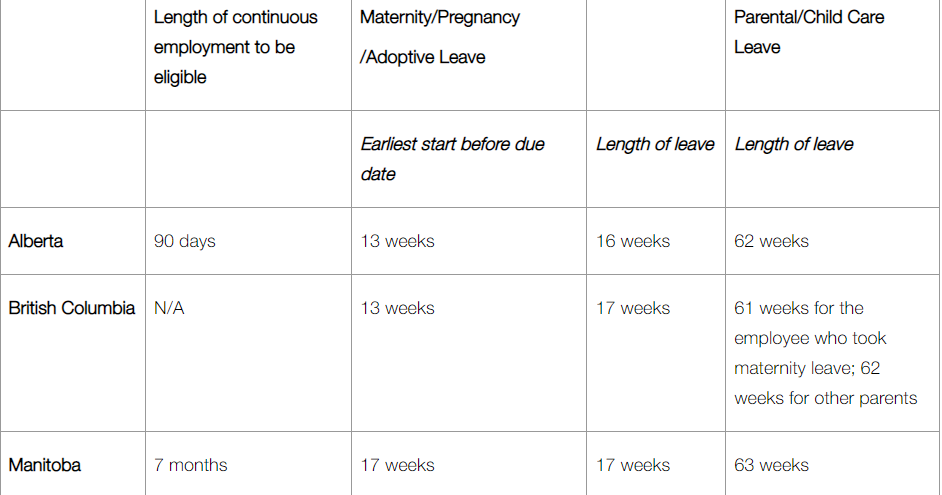
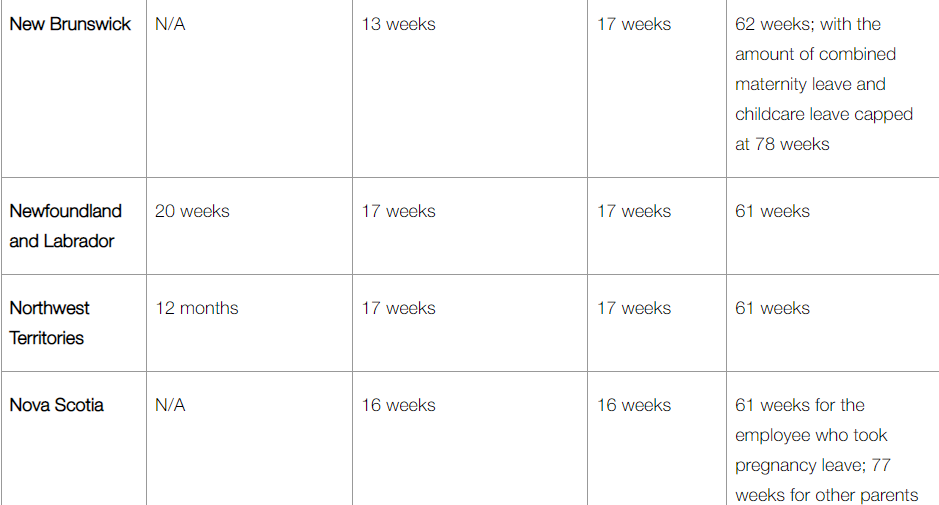
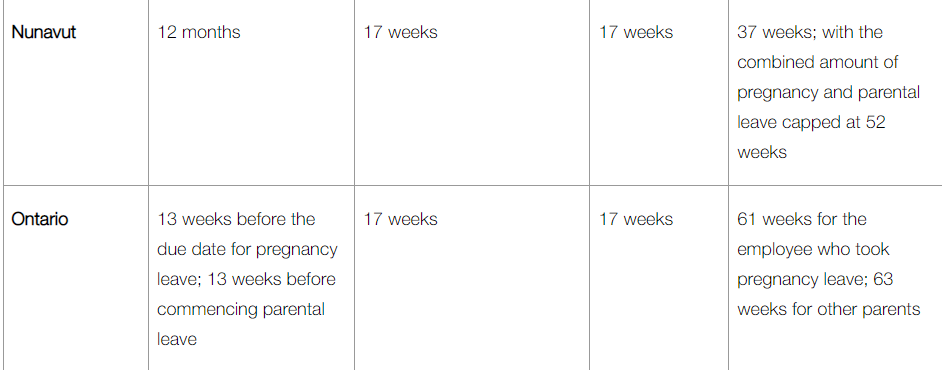


What About Quebec?
In 2006, Quebec started its own stand-alone parental benefit plan. The Quebec Parental Insurance Plan (QPIP) replaces previous benefits provided by the federal government.
Before I get into that, let me go over Quebec’s maternity, paternity, and parental leave options. Mothers can get 18 consecutive weeks of leave without pay. Quebec also offers paternity leave that includes five consecutive weeks of unpaid leave. Parents can take this during the week of the baby’s birth at the earliest.
As for parental leave, parents of newborns or adopted children can get parental leave of up to 65 weeks. This leave is unpaid and is in addition to maternity and paternity leave.
Quebec Parental Insurance Plan
When Quebec adopted this plan in 2006, it did so because it saw a need for it. Officials within the province saw parental leave as an advantage, one that benefits society as a whole.
To start, it helps out young families and those dealing with the stresses of newborn life. With a parent at home, babies can spend their crucial early years bonding with their caregiver while going through all developmental milestones.
Once the plan went into effect, Quebec saw a large increase in new parents taking full parental leave. Nearly 90 percent of wage-earning mothers took leave in comparison to the rest of the country, where nearly 60 percent did the same.
Quebec designed the QPIP to pay benefits to all eligible workers wanting to take maternity, paternity, or parental leave.
Both salary and self-employed workers can qualify for QPIP. One of the biggest advantages of the plan is that the minimum insurable earnings used to calculate benefits is only $2,000. This is substantially below EI’s insurable wage cutoff.
QPIP plans offer two options, the standard and the special. The difference between them is the length of leave and percentage of income replaced.
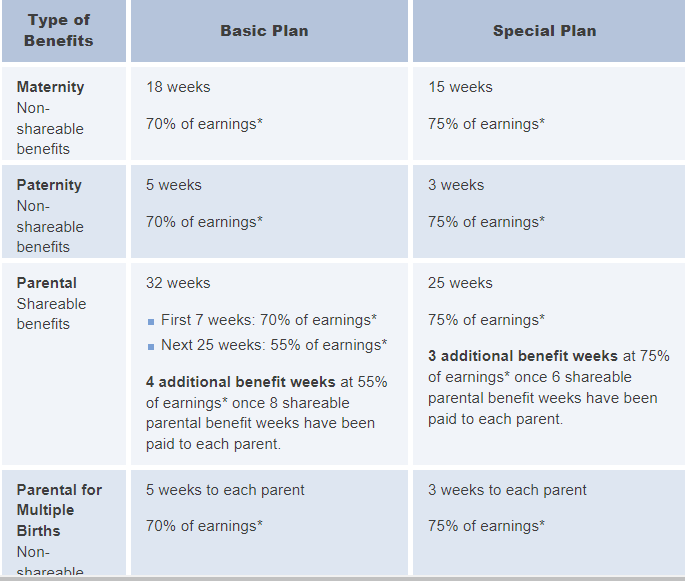
The above table showcases the differences between the two plans and the number of benefits you can receive depending on the duration of your leave.
Because Quebec has its own parental leave plan, wage earners receive a reduction in their employment insurance premiums. In addition, all wage earners, self-employed workers, and employers will pay premiums for the QPIP. The table below summarizes each premium rate.
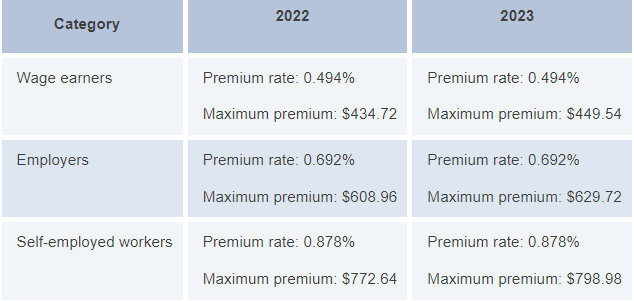
How Does Canada Compare To Other Countries?
According to a UNICEF report in 2019, Canada’s parental leave policies are somewhere in the middle when compared to other countries.
Canada ranked 19th in its parental leave available to mothers. Estonia topped the chart, with Hungary a close second.
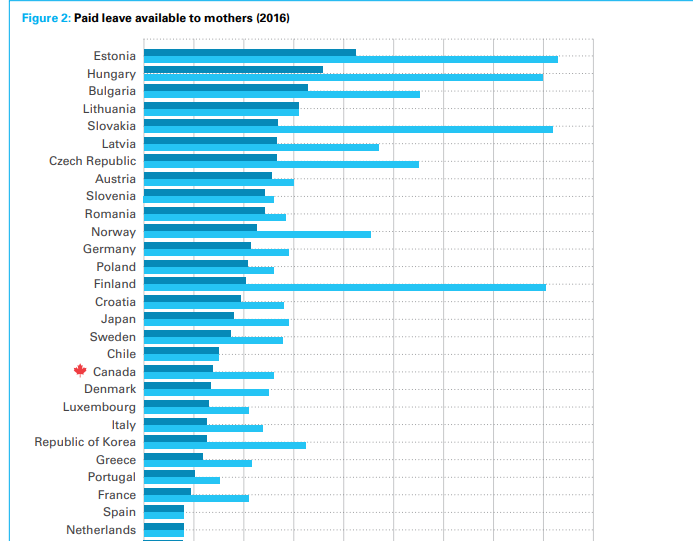
The Importance of Family-Friendly Policies
A decent maternity leave policy gives women the time to recover from childbirth while also learning how to juggle their life with a newborn.
During this important time, parents will form a bond with their children that will last a lifetime. In addition, a lengthy maternity leave helps facilitate breastfeeding, which studies have shown to be beneficial to both the mom and the infant.
A paid leave also gives parents financial stability while going through this new life change. It helps keeps children out of poverty and starts them off on the right foot. Because the leave protects parents’ jobs, they can stay stress-free and not worry about how they’ll continue to support their growing family.
Final Thoughts
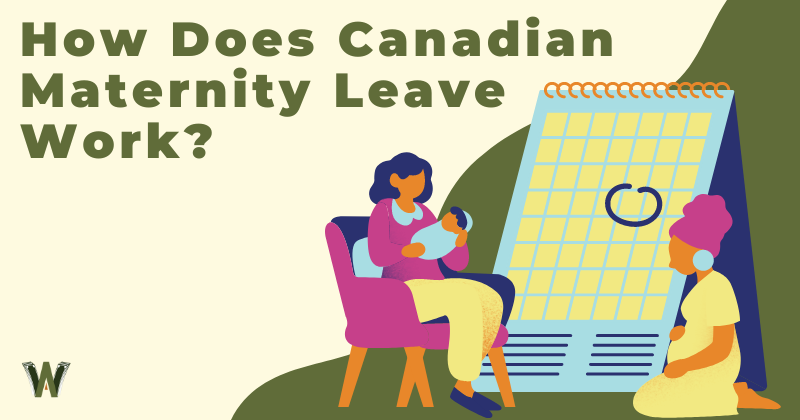
A parental leave policy that includes benefits and job protection will benefit the parents and the child. It keeps a steady income flowing during some of the most important bonding years.
Canada has a maternity and parental leave policy through the government’s Employment Insurance program. This program provides paid benefits over several weeks. Each province also has parental leave options that are usually unpaid.
EI benefits are only a portion of your earnings, so if you want to make some cash while on maternity leave, check out these four simple ideas.




